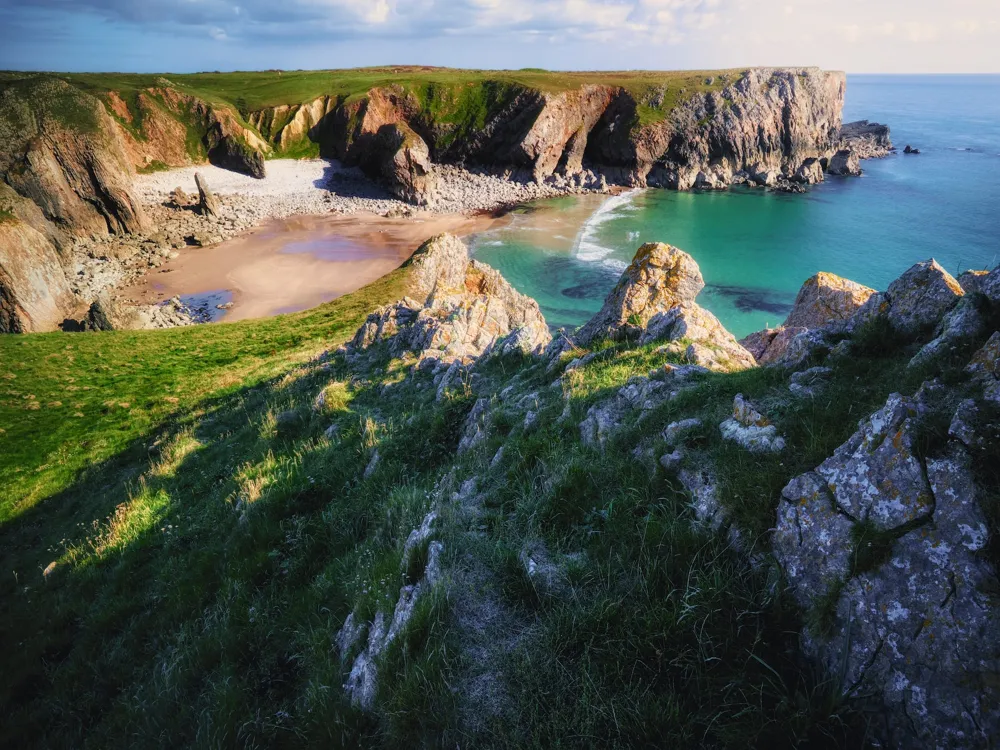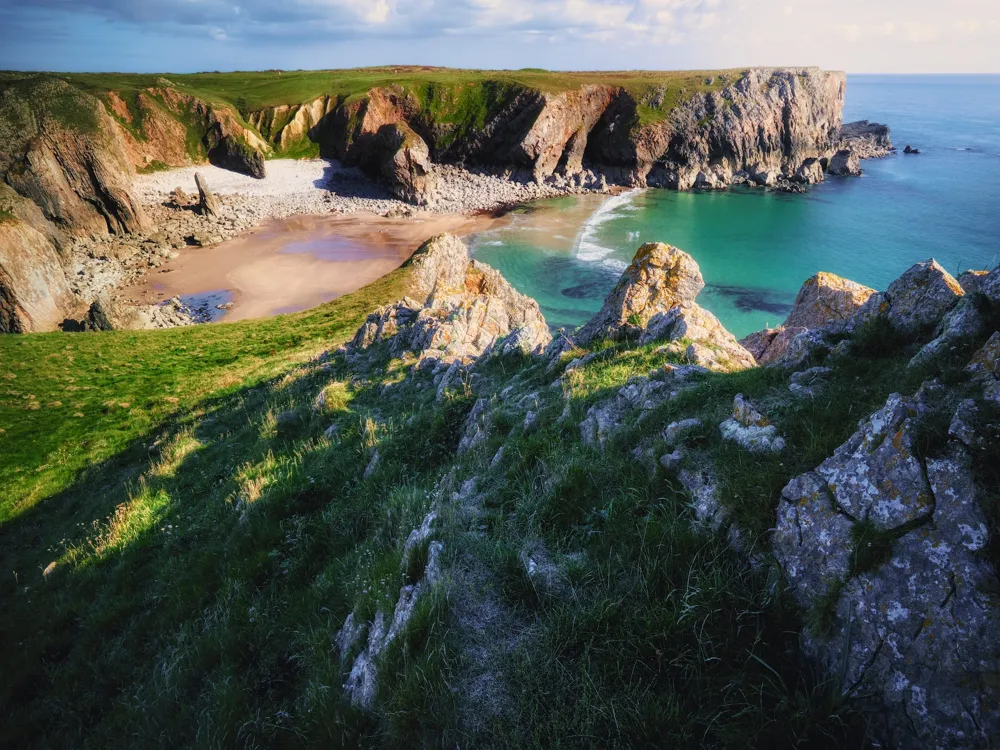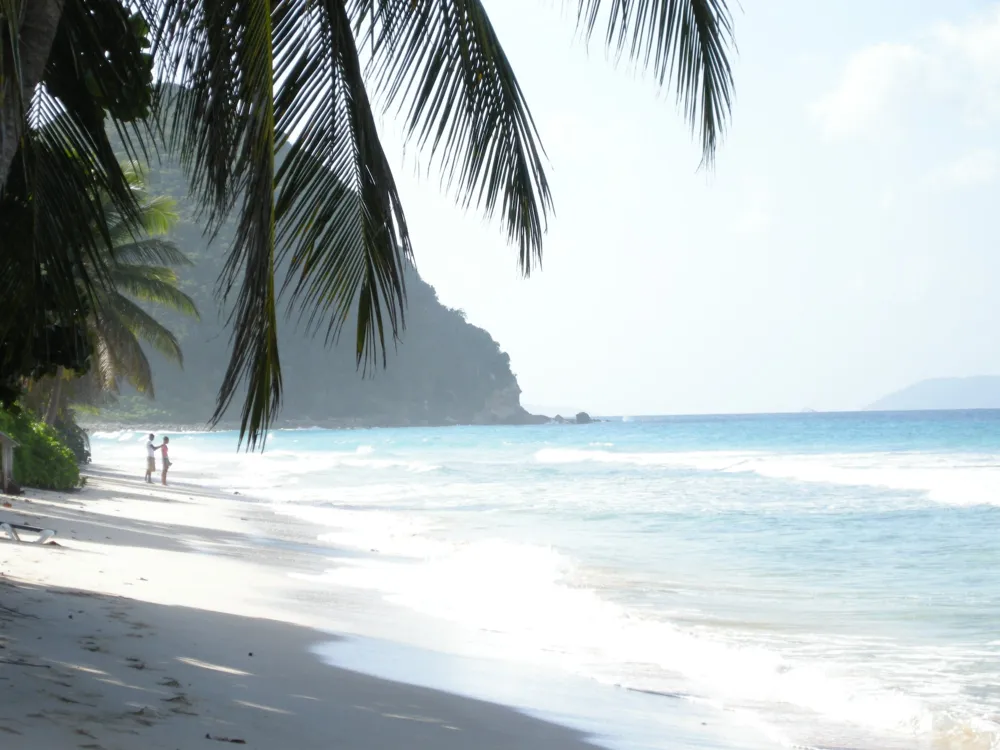Halong Bay, a magnificent natural wonder in northern Vietnam, is renowned for its stunning seascape of limestone pillars and islets. This UNESCO World Heritage site spans an area of around 1,553 square kilometers, boasting over 1,600 islands and islets, most of which are uninhabited and unaffected by human presence. The name 'Halong' translates to 'where the dragon descends into the sea', and the area is shrouded in mythical legends. The bay's geology is unique, with its towering limestone karsts that have undergone 500 million years of formation in different conditions and environments. The evolution of the karst in this bay has taken 20 million years under the impact of the tropical wet climate. The biodiversity here includes tropical evergreen bio-systems, oceanic and sea shore bio-systems. Halong Bay is home to 14 endemic floral species and 60 endemic faunal species. Historically, Halong Bay has been a cradle of ancient Vietnamese civilization with archaeological sites dating back over 18,000 years. Moreover, it's not just the landforms that mesmerize but also the floating villages and the culture of the local people. These aspects come together to create an ethereal and mystical atmosphere, making Halong Bay a fascinating destination for travelers worldwide. The limestone karsts of Halong Bay are notable for their shapes, sizes, and unique configurations. They are the result of millions of years of weathering and erosion. The bay's landscape is characterized by pillar-like formations, many of which have been named for their shapes, like the Fighting Cocks (Hon Ga Choi) and the Incense Burner (Dinh Huong). These formations are not only visually stunning but also contribute significantly to our understanding of the Earth's prehistoric past. The diverse ecosystem of Halong Bay includes lush rainforests on the larger islands, featuring a wide variety of plant and animal life. The bay is a refuge for endangered species such as antelopes, monkeys, and a myriad of bird species. Its waters harbor a plethora of marine life, including fish, squid, and shrimp, sustaining the local fishing communities. The bay's floating villages, such as Cua Van and Vung Vieng, are the epitome of cultural richness, showcasing traditional Vietnamese maritime lifestyles. The area is dotted with caves and grottoes that hold significant historical and cultural importance, such as Dau Go Cave with its stalactites and stalagmites, and Sung Sot Cave, known for its breathtaking rock formations. The architecture in Halong Bay is not about buildings; it's about the natural karst formations that dominate the landscape. Each limestone pillar and cave tells a story of geological development over millions of years. However, the man-made architecture in the area is predominantly found in the floating villages and traditional junks that ply the waters. The limestone karsts of Halong Bay are nature's architecture at its finest. These towering structures, some rising hundreds of meters above sea level, are the result of complex geological processes over millions of years. They stand as natural sculptures, their shapes and sizes creating an otherworldly landscape. The architecture of the floating villages in Halong Bay is a testament to the adaptability and resilience of the local fishing communities. These floating homes, made from bamboo and wood, are built to withstand the elements while providing a sustainable living environment. The villages are interconnected by floating markets, schools, and communal areas, creating a unique waterborne community. The traditional junks and boats of Halong Bay are a vital part of its architecture. These wooden boats, with their distinctive sails, are not just a means of transport but also a symbol of Vietnamese maritime culture. The design of these boats has been refined over centuries, adapted to navigate the bay's waters and weather conditions efficiently. The best time to visit Halong Bay is from October to April, when the weather is cooler and less rainy. This period provides optimal conditions for cruising and exploring the islands. Pack light, but don't forget essentials like swimwear, sunscreen, a hat, and insect repellent. Comfortable shoes are a must for exploring the islands and caves. Select a cruise that fits your budget and preferences. There are options ranging from luxury to budget-friendly cruises, each offering different experiences and amenities. When interacting with local communities, be respectful of their traditions and practices. It's important to support the local economy but also to be mindful of the environmental impact. Be mindful of your environmental footprint. Avoid littering, respect wildlife, and choose eco-friendly tour options when possible. To reach Halong Bay, visitors can travel by road, air, or sea. The nearest airport is in Hanoi, from where it's a 3 to 4-hour drive to Halong city. Alternatively, there are shuttle buses, private car hires, and even seaplanes that offer scenic routes to the bay. For a more scenic route, some tourists opt for a train journey from Hanoi to Halong, which takes around 7 hours. Upon reaching Halong city, numerous boat tours and cruises are available to explore the bay's iconic limestone islands and floating villages.Overview of Halong Bay
Geological Significance
Flora and Fauna
Cultural and Historical Importance
Architecture of Halong Bay
Natural Architecture: The Limestone Karsts
Floating Villages
Traditional Junks and Boats
Tips When Visiting Halong Bay
Best Time to Visit
Packing Essentials
Choosing a Cruise
Respecting Local Culture
Environmental Consciousness
How To Reach Halong Bay
Hang Bo Nau
Halong Bay
₹ 15,260 onwards
View halong-bay Packages
Halong-bay Travel Packages
View All Packages For Halong-bay
Top Hotel Collections for Halong-bay

Private Pool

Luxury Hotels

5-Star Hotels

Pet Friendly
Top Hotels Near Halong-bay
Other Top Ranking Places In Halong-bay
View All Places To Visit In halong-bay
View halong-bay Packages
Halong-bay Travel Packages
View All Packages For Halong-bay
Top Hotel Collections for Halong-bay

Private Pool

Luxury Hotels

5-Star Hotels

Pet Friendly






















